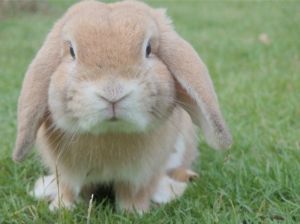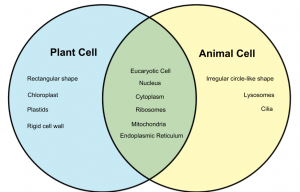Difference between Animal Cell and Plant Cell
Plant cells and animal cells have many similarities, but have vast differences as well. For example, the plant cell has a regular rectangular shape, while the animal cell has an irregular circle-like shape. Both cells are eukaryotic cells and therefore both have similar organelles. This article is going to compare and contrast both cells and define their most relevant traits.
Key Characteristics[edit]
The chloroplast in plant cells facilitates the production of energy through a process called photosynthesis. There is no chloroplast in an animal cell; the animal cell obtains energy from glucose through a process called cellular respiration. In terms of structure, all animal cells have centrioles while only lower forms of plants have centrioles. Plant cells are surrounded by a rigid cell wall that encloses the cell membrane but this is absent in Animal cells. However, animal cells have one or more small vacuoles responsible for storing water, ions and waste while plant cells have one large central vacuole responsible for storing water and maintaining cell turgidity.
Both cells have a cytoplasm which is a jelly-like fluid that supports the cell organelles. Ribosomes and mitochondria are also present in both cells with the former making protein to support cellular function and the later producing energy for cellular use.
Plastid are present in plant cells and are used to store vital pigments but they are absent in animal cells. The endoplasmic reticulum is also present in both cells and plays many important roles in protein synthesis. Other organelles present in both cells include microtubules and nucleus. Flagella and Cilia can sometime be found in both cells, although most plant cells do not contain a cilia. Absent in plant cells but present in animal cells are lysosomes which play an important part in digestion and waste removal.
| Animal Cell | Plant cell | |
|---|---|---|
| Cell wall | Absent. | Present. |
| Shape | Round. | Rectangular. |
| Vacuole | One /more smaller vacuoles. | One, big central vacuole. |
| Centrioles | Present. | Only found in lower plant forms. |
| Chloroplast | Absent. | Present. |
| Cytoplasm | Present. | Present. |
| Ribosomes | Present. | Present. |
| Mitochondria | Present. | Present. |
| Plastids | Absent. | Present. |
| Endomplasmic Reticulum (Smooth and Rough) | Present. | Present. |
| Golgi Apparatus | Present. | Present. |
| Plasma Membrane | Animal cells have cell membrane. | Plants cells have a cell membrane and a cell wall. |
| Microtubules/Microfilaments | Present. | Present. |
| Flagella | Present in some cells. | Present in some cells. |
| Lysosomes | Lysosomes located in cytoplasm. | Lysosomes not usually present. |
| Nucleus | Present | Present |
| Cilia | Present | Absent in most cells. |


